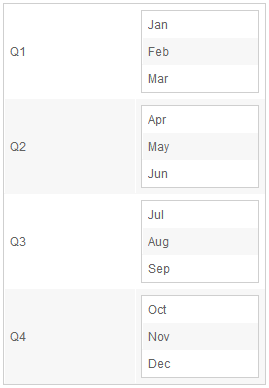Listbox Template
The template used to control the rendering of each item must be named model and declared right inside the listbox element. For example,
<listbox model="${$composer.fruits}" apply="foo.FruitProvider">
<listhead>
<listheader label="Name" sort="auto"/>
<listheader label="Weight" sort="auto"/>
</listhead>
<template name="model">
<listitem>
<listcell label="${each[0]}"/>
<listcell label="${each[1]}"/>
</listitem>
</template>
</listbox>
As illustrated above, custom rendering is defined by a template called model. The template's name is important because users are allowed to associate multiple templates to one component, and listbox's default renderer looks only for the template called model.
When the template is rendered, a variable called each is assigned with the data being rendered. Thus, you could retrieve the information to render with EL expressions, such as ${each[0]} or ${each.name}, if it is a bean with a setter called name.
Notice that, if value="${each}" is not specified to the listitem element (Listitem.setValue(Object)) in the template, listbox will automatically assign the data being rendered to the listitem's value, such that you could conveniently retrieve back the data when necessary.
The $composer.fruits expression, in this example, is expected to return a two-dimensional array[1]. It is provided by the foo.FruitProvider composer such as follows[2].
public class FruitProvider extends org.zkoss.zk.ui.select.SelectorComposer {
public String[][] fruits = new ListModelArray(
new String[][] {
{"Apple", "10kg"},
{"Orange", "20kg"},
{"Mango", "12kg"}
});
public String[][] getFruits() {
return fruits;
}
}
- ↑ Of course, it can be anything you like. Just make sure it matches the EL expressions specified in the template.
- ↑ Here we use SelectorComposer for simplicity. There are several ways to implement a composer, such as wiring a Spring-managed bean. For more information, please refer to the Composer section
Nested Listboxes
The template can be applied recursively. Here is an example of a listbox-in-listbox:
<zk>
<zscript><![CDATA[
ListModel quarters = new ListModelArray(new String[] {"Q1", "Q2", "Q3", "Q4"});
Map months = new HashMap();
months.put("Q1", new ListModelArray(new String[] {"Jan", "Feb", "Mar"}));
months.put("Q2", new ListModelArray(new String[] {"Apr", "May", "Jun"}));
months.put("Q3", new ListModelArray(new String[] {"Jul", "Aug", "Sep"}));
months.put("Q4", new ListModelArray(new String[] {"Oct", "Nov", "Dec"}));
ListModel qs = (quarters);
]]></zscript>
<listbox model="${quarters}">
<template name="model">
<listitem>
<listcell>${each}</listcell>
<listcell>
<listbox model="${months[each]}">
<template name="model">
<listitem label="${each}"/>
</template>
</listbox>
</listcell>
</listitem>
</template>
</listbox>
</zk>
To access the data of the outer template from the inner template, use the parent listitem's Listitem.getValue() where the data is stored by default. Please look at line 8 of the following example, data can be retrieved from the outer model by travelling the component tree
<listbox model="${quarters}">
<template name="model">
<listitem>
<listcell>
<listbox model="${months[each]}">
<template name="model">
<listitem>
<listcell label="${forEachStatus.index}" />
<listcell>${self.parent.parent.parent.parent.parent.value}</listcell>
<listcell>${each}</listcell>
</listitem>
</template>
</listbox>
</listcell>
</listitem>
</template>
</listbox>
Notice that, unlike the forEach attribute, the forEachStatus is only available in the near template scope when the nested listbox is about to render.
Template for GroupsModel
When used with GroupsModel, listboxes will use the template called model:grouping for rendering the grouping object. If it is not defined, it will look for the template called model instead (i.e., the same template is used for rendering the grouping and non-grouping objects).
<listbox mode="${fooGroupsModel}">
<template name="model:group">
<listgroup open="${groupingInfo.open}" label="${each}"/>
</template>
<template name="model">
<listitem>....</listitem>
</template>
<template name="model:groupfoot">
<listgroupfoot>....</listgroupfoot>
</template>
<listbox>
- Note the groupingInfo is used to get the information of the grouping data. Please refer to GroupingInfo
Version History
| Version | Date | Content |
|---|---|---|
| 6.0.0 | July 2011 | The template feature was introduced. |
| 6.0.0 | January 2012 | The GroupingInfo statement was introduced. |

